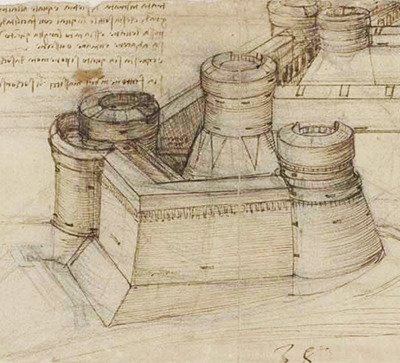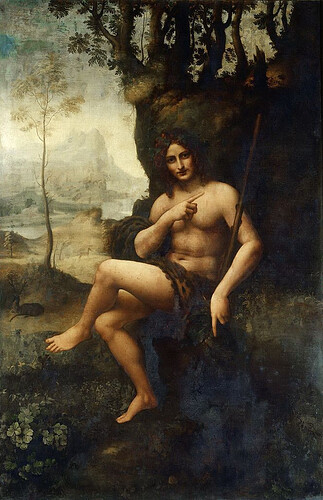Leonardo di ser Piero da Vinci (meaning: Leonardo son of Piero from Vinci) better known as Leonardo da Vinci, or just Da Vinci is one of the mst popular figures from the Renaissance, and possibly the closest embodiment to the “ideal Renaissance Man”. Both these things are attributed to the fact that he studied (and made advances in) several fields through his life.
nowadays, he’s mostly known as “the man who painted the Mona Lisa” (or some other of his paintings), and while those are remarkable works, there’s so much more he did, i want to share some of those things with you guys today:
for starters: his knowledge of anatomy did not only apply to his art
Da Vinci had multiple sketches and studies on both human and animal anatomy, which helped the development of medical studies, specially physiology, during the renaissance, his studies are very detailed, (cw: (implied) gore (?), corpses, grave robbing) which one could not know just by looking at a person. What he did was study the anatomy from corpses which he acquired through… not so legal means. While he was not the one who dug up bodies from graves, he did pay people to do that for him, and then he’d study the bodies. eventually he got permission to keep doing so, but at the start, Da Vinci was willing to do it despite the law.
and anatomy sketches aren’t the only interesting thing one would find going through his notebooks, he also left us multiple machine sketches, which have helped engineering (and while i may be wrong, i believe these still help with it to this day)
he never got to see machines of his (like the flying machines) work
but he paved the way for those who came after him, and i believe without him, aviation as we know it would be… quite different, and the process to making planes like the ones we have today could have taken longer
sketches!
(original painting by Da Vinci, laurel wreath and details on the skin covering him added by an anonymous painter)
one of his disciplines not many people talk about is architecture, but some have come to call him a visionary in this field as well, which makes sense considering how well versed he was in maths and geometry
now, multiple sources confirm Da Vinci was an sculptor as well, but (according to the Smithsonian) there is only one of his sculptures that managed to survive til the present day, so there’s not much that can be said about it
and while it may not be as important to note, Da Vinci learnt Latin while growing up (which doesn’t mean much, given that everyone did back then)
what IS important to note, however, is the fact that this education he received was informal.
Leonardo da Vinci was a b*stard, in the literal sense of the word, and because of this, he did not receive a formal education, which makes all his knowledge more impressive.
another thing i want to note about Da Vinci’s life is that, even with all his genius and all the advances he made possible, he was not quite… accepted by society back then. not only for being a b*stard, but for being a sodomite as well.
if you don’t know what a sodomite is, it’s a man who engaged in homosexual activities (and i’m blurring it because it has some sexual connotations).
but saying that Da Vinci was gay is a bit of an anachronism, as the concept of being gay was not a thing when he was alive.
sure, gay people have always existed, but “being gay” as it’s known today, is a construct that goes far beyond just liking men (if you are interested in the topic, Foucault has a couple interesting texts about it).
there’s evidence of Da Vinci liking men, and i’ve been looking at that stuff since i was a young teen, that’s something I won’t argue with because well, I do support that theory.
and it may be safe (from a linguistic point of view) to say that he had homosexual tendencies while there’s nothing to prove that he liked women. it may be safe to assume that this was one of the reasons he was shunned while he lived.
aside from his homosexual tendencies, there’s something else i want to talk about, something that made him queer (in the old sense of the word)
so let’s go through some of his paintings:
here we have "St. John the Baptist" and "St John the Baptist with the Attributes of Bacchus"
original painting by Da Vinci, laurel wreath and animal skin cloth were added later on by an anonymous painter who’s said to have seen the similarities between St. John and Bacchus
it was brought to my attention (by a friend who studies art history) that in these two paintings, St. John is pictured in a sort of feminine light, compared to paintings of men back then, and yet, there’s no doubt that he is a man.
and i mentioned the names of the paintings because, as some of you may know, Bacchus was a figure for gender fluidity (as in gender is a spectrum), while some say Bacchus himself was transgender.
there is one more depiction of androgyny by Da Vinci, but it’s a bit more explicit so i’m not going to show it here (if you’re an adult (and can confirm you’re an adult), DM me and i’ll give you the name of that drawing), but in short: it depicts a person, someone visually similar to St. John, with both male and female sex characteristics.
where am i going with this?
i honestly don’t know, this is wildly anachronistic but it is a topic that interests me a lot, even more so knowing that his depictions for androgyny apply for holy figures and deities.
who is to say that Da Vinci didn’t see divinity as androgynous? as something that would now be regarded as queer?
so… i talked about a lot of things (as i tend to do)
i hope you guys have things to talk about as well when it comes to this topic
- what do you think about being a polymath? would you want to master multiple disciplines as well? or would you rather stick to one or two
- would you go against the law for the pursue of knowledge?
- do you know any of Da Vinci’s inventions that could improve the world today?
- do you find any of his machines particularly interesting?
- do you think it’s important whether or not he was gay?
- what do you think about his depictions of androgyny?













 ok i read it and all i really have to say is to say is
ok i read it and all i really have to say is to say is